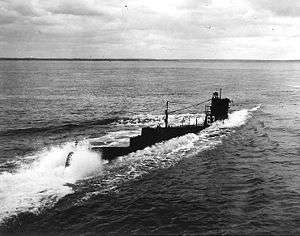USS O-2 (SS-63)
USS O-2 (SS-63) was one of 16 O-class submarines built for the United States Navy during World War I.
 O-2 during training operations, 26 November 1943 | |
| History | |
|---|---|
| Name: | USS O-2 |
| Ordered: | 3 March 1916 |
| Builder: | Puget Sound Navy Yard, Bremerton, Washington |
| Laid down: | 27 July 1917 |
| Launched: | 24 May 1918 |
| Commissioned: | 19 October 1918 |
| Decommissioned: | 25 June 1931 |
| Recommissioned: | 3 February 1941 |
| Decommissioned: | 26 July 1945 |
| Stricken: | 11 August 1945 |
| Fate: | Sold for scrap, 16 November 1945 |
| General characteristics | |
| Class and type: | O-class submarine |
| Displacement: |
|
| Length: | 172 ft 3 in (52.5 m) |
| Beam: | 18 ft 1 in (5.5 m) |
| Draft: | 14 ft 5 in (4.4 m) |
| Installed power: |
|
| Propulsion: |
|
| Speed: |
|
| Range: | 5,500 nmi (10,200 km; 6,300 mi) at 11.5 knots (21.3 km/h; 13.2 mph) on the surface |
| Test depth: | 200 feet (61.0 m) |
| Complement: | 2 officers, 27 men |
| Armament: |
|
Description
The O-class submarines were designed to meet a Navy requirement for coastal defense boats.[1] The submarines had a length of 172 feet 3 inches (52.5 m) overall, a beam of 18 feet 1 inch (5.5 m) and a mean draft of 14 feet 5 inches (4.4 m). They displaced 521 long tons (529 t) on the surface and 629 long tons (639 t) submerged. The O-class submarines had a crew of 29 officers and enlisted men. They had a diving depth of 200 feet (61.0 m).[2]
For surface running, the boats were powered by two 440-brake-horsepower (328 kW) diesel engines, each driving one propeller shaft. When submerged each propeller was driven by a 370-horsepower (276 kW) electric motor. They could reach 14 knots (26 km/h; 16 mph) on the surface and 10.5 knots (19.4 km/h; 12.1 mph) underwater. On the surface, the O class had a range of 5,500 nautical miles (10,200 km; 6,300 mi) at 11.5 knots (21.3 km/h; 13.2 mph).[2]
The boats were armed with four 18 inch (450 mm) torpedo tubes in the bow. They carried four reloads, for a total of eight torpedoes. The O-class submarines were also armed with a single 3"/50 caliber deck gun.[2]
Construction and career
O-2 was laid down on 27 July 1917 by the Puget Sound Navy Yard. She was launched on 24 May 1918, and commissioned at Puget Sound on 19 October 1918 with Lieutenant Commander F. T. Chew in command.
Service history
During World War I, O-2 patrolled off the New England coast until war's end. Reclassified as a second line submarine on 25 July 1924, and reverting to a first liner on 6 June 1928, she served at the submarine base, New London, Connecticut, in training officers and men until 1931, except for a brief tour at Coco Solo, Panama Canal Zone, in 1924. In 1931, she transferred to Philadelphia, Pennsylvania, where she decommissioned on 25 June 1931.
With increasing possibility of U.S. involvement in World War II, O-2 recommissioned at Philadelphia on 3 February 1941. Steaming to New London in June, she trained submarine crews there until after Germany collapsed. She decommissioned on 26 July 1945, was struck on 11 August 1945, and was sold on 16 November 1945.
Awards
- World War I Victory Medal
- American Defense Service Medal
- American Campaign Medal
- World War II Victory Medal
Notes
- Friedman, pp. 86–87
- Gardiner & Gray, p. 129
References
- Friedman, Norman (1995). U.S. Submarines Through 1945: An Illustrated Design History. Annapolis, Maryland: Naval Institute Press. ISBN 1-55750-263-3.
- Gardiner, Robert & Gray, Randal, eds. (1985). Conway's All the World's Fighting Ships: 1906–1921. Annapolis, Maryland: Naval Institute Press. ISBN 0-85177-245-5.
This article incorporates text from the public domain Dictionary of American Naval Fighting Ships. The entry can be found here.
External links
- Photo gallery of USS O-2 at NavSource Naval History